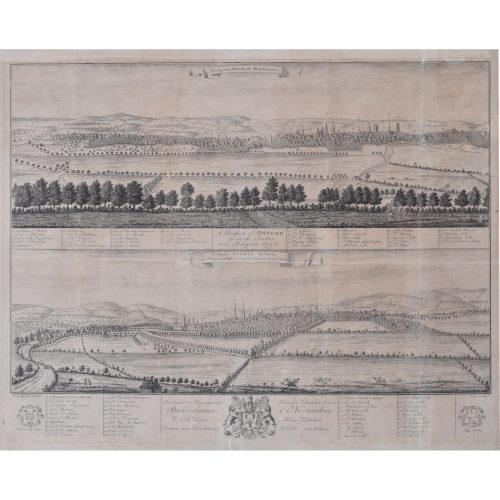-
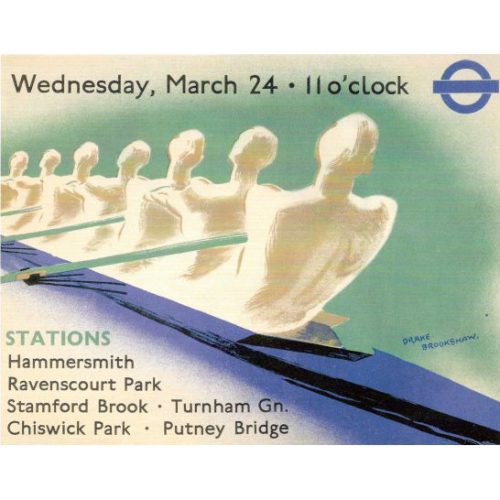
Percy Drake Brookshaw (1907-1993) Boat Race
Lithograph in colours, 1937 25 x 30cm (10 x 12.5 inches) Vintage Oxford v Cambridge Boat Race poster from 1937. These small posters were designed to be utilised on buses. Born in Southwark and educated at the Central Schools of Arts and Crafts, Drake Brookshaw was a renowned designer for the Underground Group and London Transport between 1928 and 1958. His wonderful posters evoke a feeling of movement, and probably none more so than this one as the seven visible men strain on their oars. His clever use of colour includes both light blue for Cambridge, and dark blue for Oxford. If you are interested in something similar, or have something similar to sell email info@manningfineart.co.uk or call us on 07929 749056. -
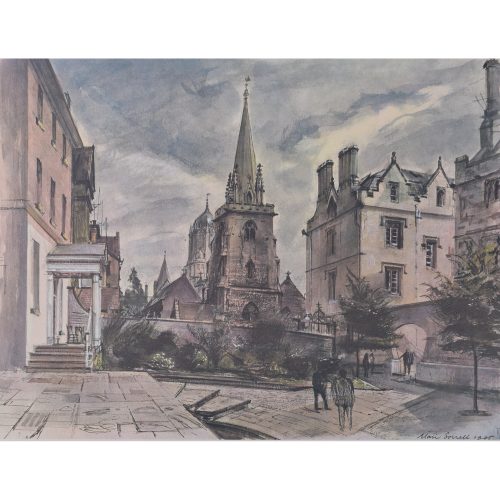
Alan Sorrell (1904 - 1974)
Pembroke College, View from the North Quadrangle (1966)
Lithograph 36 x 50 cm A lithograph of Pembroke's North Quad, from a drawing by Alan Sorrell. The artist's striking use of perspective and nebulously sketched figures make it a good example of Sorrell's style. Sorrell's 1965 etching was reproduced as a lithograph a year later, to be published in the "Oxford Almanack". The Oxford Almanack was an annual almanac published by the Oxford University Press for the University of Oxford from 1674 through 2019 (when printing sadly ceased due to "dwindling interest"). The almanac traditionally included engravings or lithographs of the University and information about the upcoming year. Other almanac artists have included James Basire, Michael Burghers, J. M. W. Turner, and John Piper. Alan Ernest Sorrell was an English artist and writer best remembered for his archaeological illustrations, particularly his detailed reconstructions of Roman Britain. Sorrell trained at the Southend municipal school of art and, after a brief spell as a commercial artist in London, he attended the Royal College of Art between 1924 and 1927. He was a Senior Assistant Instructor of Drawing there between 1931 and 1939, and again between 1946 and 1948. In 1937 he had been elected a member of the Royal Watercolour Society, and during the war served as a camofleur. After the war, Sorrell's archaeological and architectural work became their focus. Condition: very good. If you’d like to know more, please email info@manningfineart.co.uk or call us on 07929 749056. -
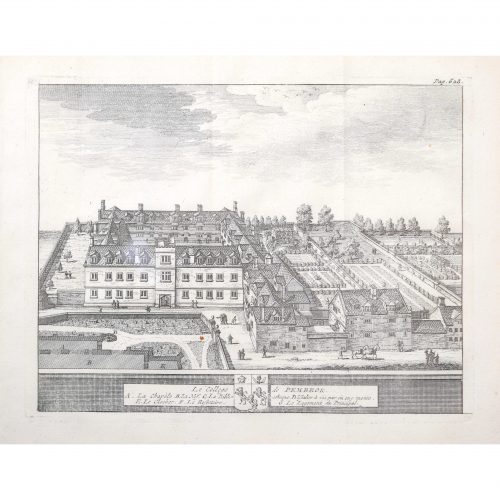
Pieter van der Aa (1659-1733), after David Loggan (1634–1692)
Pembroke College, Oxford (1727)
Engraving 12 x 16 cm An eighteenth-century view of Pembroke College, Oxford, engraved by Pieter van der Aa after an earlier one by David Loggan, the noted engraver, draughtsman, and painter. Pieter van der Aa of Leiden was a Dutch publisher best known for preparing maps and atlases, though he also printed editions of foreign bestsellers and illustrated volumes. He is noted for the many engravings he produced after David Loggan's series of Oxford and Cambridge colleges and costumes. In 1727 Van Der Aa illustrated "Les Delices de la Grande Bretagne & de L'Irelande" by James Beeverell, the book in which this engraving appears. Condition: a good impression. If you’d like to know more, please email info@manningfineart.co.uk or call us on 07929 749056. -
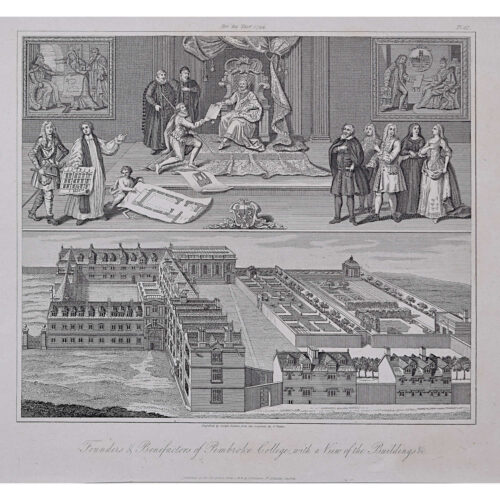
Joseph Skelton (1783 - 1871) after George Vertue (1684 - 1756)
Founders & Benefactors of Pembroke College, with a View of the Buildings &c. (1818)
Engraving 21 x 24 cm A historic engraving of Pembroke's august founders and early architecture, which later formed part of the artist's 1828 'Pietas Oxoniensis, or Records of Oxford Founders'. George Vertue FSA was an English engraver and antiquary. He was apprenticed to a heraldic engraver in France, then worked for the Flemish engraver Michael Vandergucht before setting up on his own. He was also a student of the English portrait painter and copyist Thomas Gibson. He became the official engraver to the Society of Antiquaries when it was founded in 1717, and his patrons included several British aristocrats. He is buried in Westminster Abbey. Joseph Skelton was an a topographical and antiquarian engraver. He lived in Oxford for a time and became a Fellow of the Society of Antiquaries of London. His Oxford publications include the Oxonia Antiqua Illustrata; Antiquities of Oxfordshire, from drawings by F. Mackenzie; and the Pietas Oxoniensis, or Records of Oxford Founders. Condition: generally very good. If you are interested, please email info@manningfineart.co.uk or call us on 07929 749056. Click here for other views of Pembroke College, Oxford. -
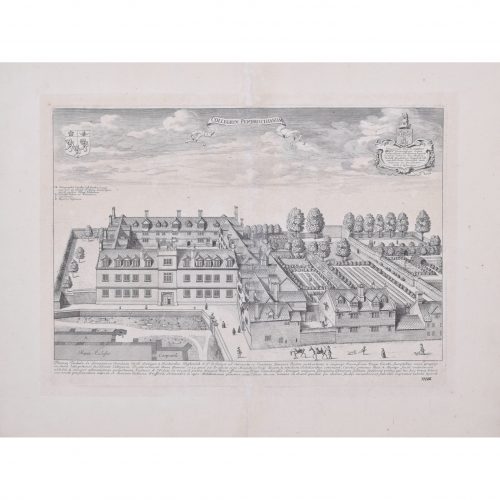
David Loggan (1634 - 1692)
Pembroke College, Oxford (1705)
Engraving 31 x 44 cm Loggan's view of Pembroke from the second edition of the 'Oxonia Illustrata'. Loggan was born to English and Scottish parents, and was baptised in Danzig in 1634. After studying engraving in Danzig with Willem Hondius (1598-1652 or 1658), he moved to London in the late 1650s, going on to produce the engraved title-page for the folio 1662 Book of Common Prayer. He married in 1663 and moved to Nuffield in Oxfordshire in 1665. Loggan was appointed Public Sculptor to the nearby University of Oxford in the late 1660s, having been commissioned to produce bird’s-eye views of all the Oxford colleges. He lived in Holywell Street as he did this. The 'Oxonia Illustrata' was published in 1675, with the help of Robert White (1645-1704). Following its completion, Loggan began work on his equivalent work for Cambridge; the 'Cantabrigia Illustrata' was finally published in 1690, when he was made engraver to Cambridge University. The 'Oxonia Illustrata' also includes an engraving of Winchester College (Winchester and New College share William of Wykeham as their founder) whilst the 'Cantabrigia Illustrata' includes one of Eton College (which shares its founder, Henry VIII, with King’s College). Bird’s-eye views from this era required a particular talent as an architectural perspectivist; it was not until 1783 that it became possible for artists to ascend via hot air balloons and view the scenes they were depicting from above. Loggan thus had to rely on his imagination in conceiving the views. Loggan’s views constitute the first accurate depictions of the two Universities, in many ways unchanged today. Whilst the Oxford engravings were produced in reasonable numbers and ran to a second edition by Henry Overton (on thicker paper and with a plate number in Roman numerals in the bottom right-hand corner), those of Cambridge were printed in much smaller numbers. The Dutchman Pieter van der Aa published some miniature versions of the engravings for James Beverell’s guidebook to the UK, 'Les Delices de la Grande Bretagne' (circa 1708). The contemporary artist Andrew Ingamells (born 1956) has produced a highly-acclaimed series of etchings which bring Loggan’s original vision up to date. Condition: good. Backed to Japanese Paper. Evidence of some historic separation to central fold. If you are interested, please email info@manningfineart.co.uk or call us on 07929 749056. Click here for other views of Pembroke College, Oxford. -
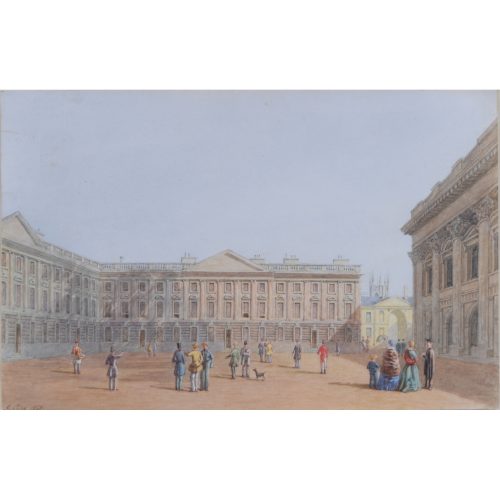
George Pyne (1800 - 1884)
Peckwater Quad, Christ Church, Oxford
Watercolour 27.5 x 17.5 cm Signed and dated 1849. A marvellous view of the Peckwater Quadrangle, more affectionately referred to as Peck Quad and known for having arguably the best undergraduate rooms in all of Oxford. The buildings on the north, east and west sides of the quad were designed by Henry Aldrich are one of the earliest examples of English neo-Palladian architecture. They were built by William Townsend between 1706 and 1711, while the Library on the south side was completed later in the eighteenth century. Peck looks rather different today - it is now mostly filled with lawn and hosts Christ Church's extremely large Christmas tree each year. In Pyne's day it was lawnless and filled with elegant pedestrians in nineteenth-century costume; in this view, afternoon light slants down over the buildings, and the lengthening shadows cast by the library creep into the quad. George Pyne was related to two founders of the Society of Painters in Watercolours - William Henry Pyne was his father, and John Varley his father-in-law. Pyne trained as an architectural draughtsman and lived in Oxford from the 1850s until his death in 1884, specialising in views of the city and its colleges. His Oxford pictures are both architecturally-minded and romantically creative, often combining intensely detailed depictions of college buildings with imagined pedestrian scenes. Pyne was also noted for his views of Cambridge and Eton, and for his drawing manuals 'A Rudimentary and Practical Treatise on Perspective for Beginners' (1848) and 'Practical Rules on Drawing for the Operative Builder, and Young Student in Architecture' (1854); the latter texts offer an insight into his method of depicting architecture and its surroundings. Condition: very good. If you are interested, please email info@manningfineart.co.uk or call us on 07929 749056. Click here for other views of Christ Church. -
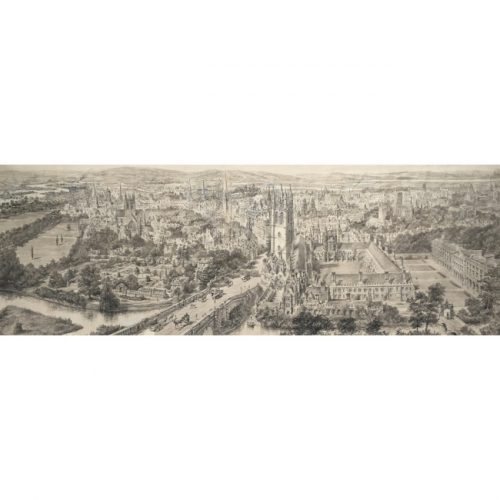
Henry William Brewer (1836 - 1903)
Panorama of Oxford (1893)
Pen and ink heightened with body colour 40 x 123 cm Signed and dated 1893. Published in The Graphic as a photogravure image. A huge and beautifully-detailed panorama of Oxford at the end of the nineteenth century. POA. Condition: very good. If you are interested, please email info@manningfineart.co.uk or call us on 07929 749056. Click here for other views of the city of Oxford. -
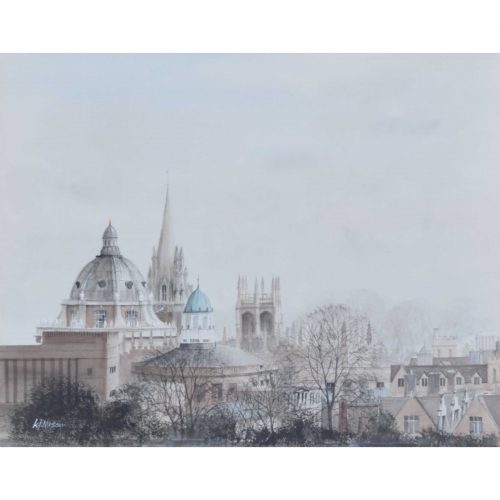
Ken Messer (1931 - 2018)
Dreaming Spires
Watercolour 30 x 38 cm Signed lower left. Oxford's skyline, including the Radcliffe Camera, the spire of University Church of St Mary the Virgin, and Magdalen Tower, is silhouetted against the grey sky of a winter day. The trees in the foreground are stark and black. Messer's depiction of Oxford's dreaming spires is an outstanding architectural record of the city's - and University's - most remarkable buildings. The painter and draughtsman Ken Messer is closely related to Oxford and its architecture in several ways. Born in Newport, South Wales, he was educated at the City of Oxford High School for Boys in Oxford, and then spent six years working as an accountant in Oxford. He then joined British Overseas Airways Corporation (BOAC) as a steward, flying internationally. Injury due to a car accident during the 1960s meant that he joined the design department of Pergamon Press in Oxford at the age of 33. Six years later, he was appointed to the position of studio manager, in charge of art and design. In 1974, Messer left Pergamon Press to become a freelance graphic designer. He started painting more watercolours, becoming a full-time artist. During the 1980s, his ink drawings were regularly published in the Oxford Times. He has sometimes been called "The Oxford Artist" because of his large number of works depicting Oxford. He and his wife Dilys lived at first in Richmond upon Thames and then in Abingdon, just south of Oxford. Messer's work has been shown at the Mall Galleries for the annual exhibitions of the Royal Institute of Painters in Water Colours annual exhibitions. Condition: excellent. If you’d like to know more, please email info@manningfineart.co.uk or call us on 07929 749056. -
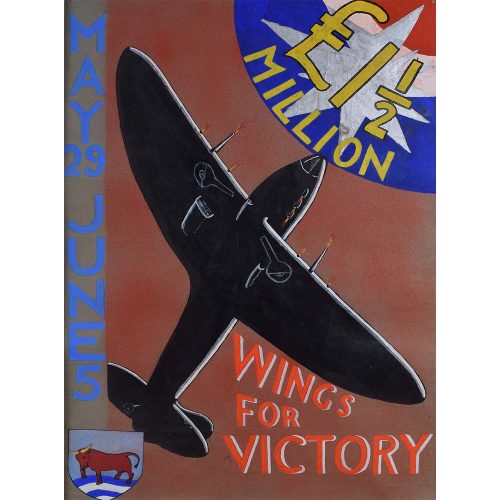
Anonymous
Oxford Wings for Victory Poster Design
56x38cm 62x44cm including hand-finished black frame. Gouache on paper c. 1943 Click here to see other posters from this series and for more information on Wings for Victory campaigns. If you are interested email info@manningfineart.co.uk or call us on 07929 749056. Condition: excellent, framed. -
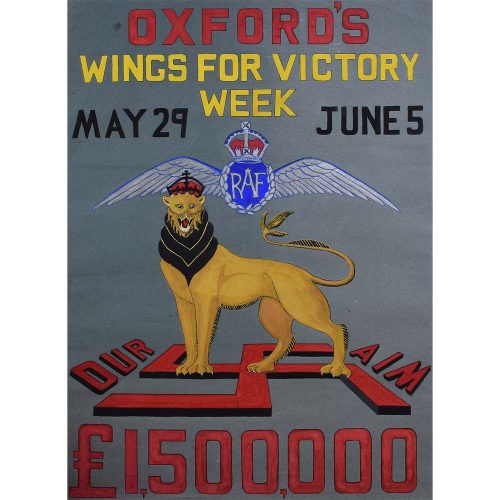
Anonymous
Oxford Wings for Victory Poster Design IV
c.1943 Gouache on paper 70 x 51 cm 89 x 68 cm including hand-finished frame, UK shipping only Click here to see other posters from this series. If you are interested email info@manningfineart.co.uk or call us on 07929 749056. Condition: Excellent. -
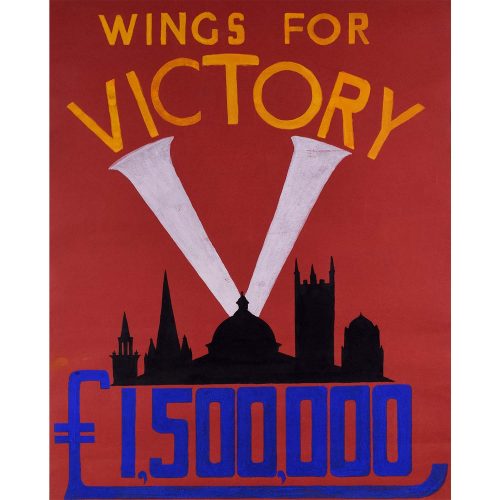
Anonymous
Oxford Wings for Victory Poster Design II
c.1943 Gouache on paper 63 x 50 cm 81x66cm including hand-finished frame, UK shipping only Click here to see other posters from this series. If you are interested email info@manningfineart.co.uk or call us on 07929 749056. Condition: Excellent. -
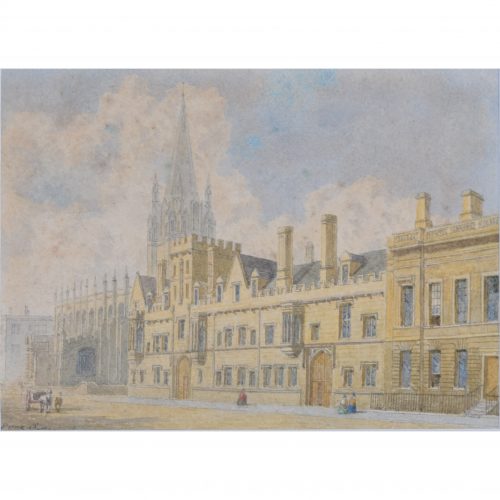
George Pyne (1800 - 1884) The High, Oxford
Watercolour 15 x 21 cm Signed and dated indiscriminately lower left. A 19th-century view of the High Street, Oxford. The spire of the University Church of St Mary the Virgin towers over the street; a horse and cart and brightly-dressed pedestrians pass by. George Pyne was related to two founders of the Society of Painters in Watercolours – William Henry Pyne was his father, and John Varley his father-in-law. Pyne trained as an architectural draughtsman and lived in Oxford from the 1850s until his death in 1884, specialising in views of the city and its colleges. His Oxford pictures are both architecturally-minded and romantically creative, often combining intensely detailed depictions of college buildings with imagined pedestrian scenes. Pyne was also noted for his views of Cambridge and Eton, and for his drawing manuals ‘A Rudimentary and Practical Treatise on Perspective for Beginners’ (1848) and ‘Practical Rules on Drawing for the Operative Builder, and Young Student in Architecture’ (1854); the latter texts offer an insight into his method of depicting architecture and its surroundings. Condition: generally good; some spotting and toning to sky. If you’d like to know more, please email info@manningfineart.co.uk or call us on 07929 749056. -
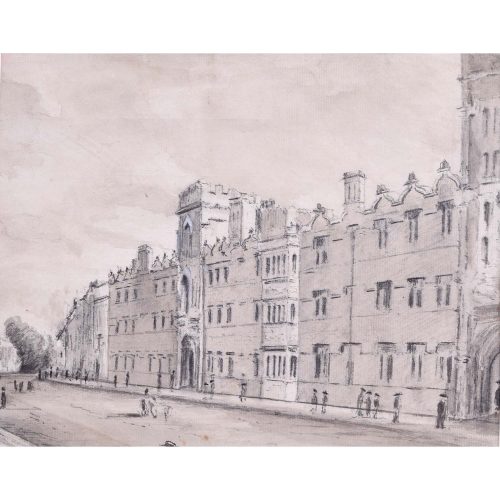
Anonymous
Oxford High Street (c.1840)
Pencil & wash on paper 18x23cm If you are interested email info@manningfineart.co.ukor call us on 07929 749056. Condition: Good. -

Pieter van der Aa (1659-1733), after David Loggan (1634–1692)
Oxford from the East (1727)
Engraving 12 x 16 cm An eighteenth-century view of Oxford from the east, engraved by Pieter van der Aa after David Loggan, the noted engraver, draughtsman, and painter. The skies are wide and full of the University's dreaming spires. Pieter van der Aa of Leiden was a Dutch publisher best known for preparing maps and atlases, though he also printed editions of foreign bestsellers and illustrated volumes. He is noted for the many engravings he produced after David Loggan's series of Oxford and Cambridge colleges and costumes. In 1727 Van Der Aa illustrated "Les Delices de la Grande Bretagne & de L'Irelande" by James Beeverell, the book in which this engraving appears. Condition: a good impression. If you’d like to know more, please email info@manningfineart.co.uk or call us on 07929 749056. -
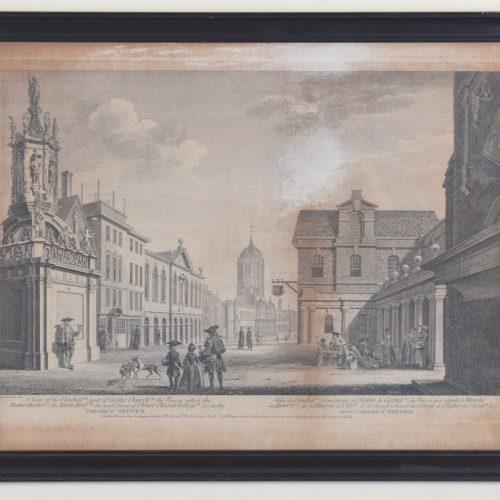
John Donowell (flourished 1753 - 1786) A View of the Conduit part of Carfax Church, the Piazza called the Butter Market, the Town Hall, the West Front of Christ Church College, &c. in the University of Oxford (1750)
Engraving 29 x 42 cm An eighteenth century view of St Aldate''s, featuring the west front of Christ Church and the Town Hall. Undergraduates, academics, and townspeople saunter along, all under the watchful eye of Tom Tower. John Donowell was an eighteenth-century British architect and engraver, considered to be one of the principal architect-draughtsmen in the latter part of the eighteenth century. He exhibited in 1761 at the Free Society, then through the 1760s at the Society of Artists, and from 1778 to 1786 at the Royal Academy; prints, some hand-coloured, were published at this time. Condition: some browning; antique frame with old glass. If you’d like to know more, please email info@manningfineart.co.uk or call us on 07929 749056.

